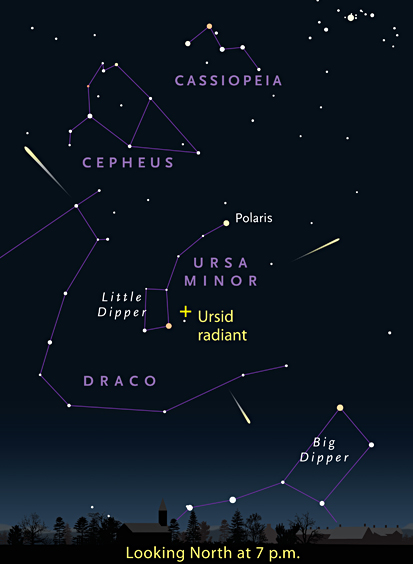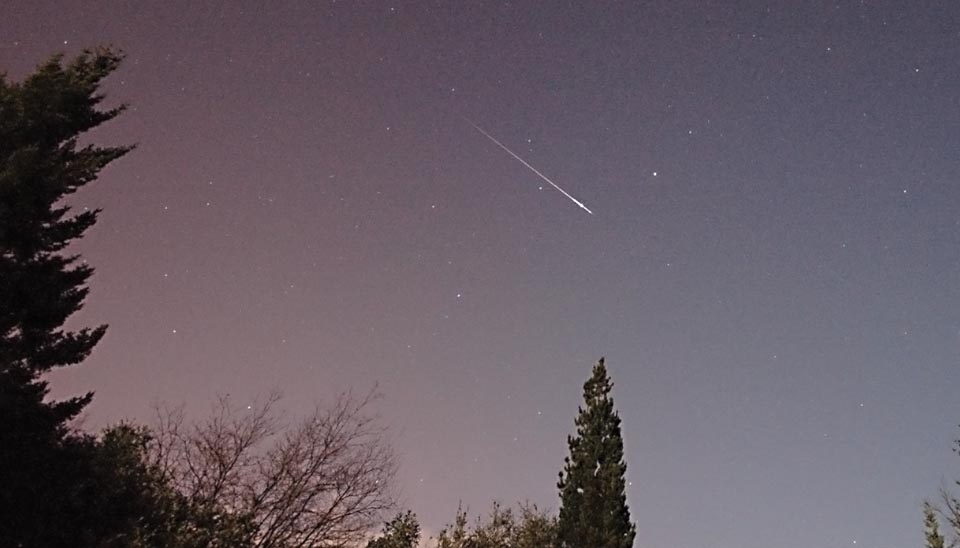Try your hand at observing the handful of "shooting stars" delivered by this little-known annual meteor shower.
December's full Moon made a mess of usually reliable Geminid meteor stream, which peaked on the night of December 13–14. So let's turn some needed attention to December's other significant meteor shower: the Ursa Minorids, more commonly called the Ursids, which are briefly active a few days before Christmas.

Sky & Telescope diagram
The Ursids' nominal peak lasts just a half day — that's how long rates should be at least 50% of maximum. This year's is predicted to come around 9h Universal Time on Thursday, December 22nd. That's well timed for North America, especially the West, corresponding to around 4 a.m. EST and 1 a.m. PST.
As the diagram at right shows, the shower's radiant is near the medium-bright star Kochab in the bowl of the Little Dipper. This point is circumpolar, just 15° from the north celestial pole, so the Ursids are active all night (and all day). The radiant stands highest just before dawn, but this year the waning Moon, one day past third quarter, rises around 1 a.m. local time. So your best prospects are from nightfall on the 21st until moonrise; the radiant changes altitude little during this time.
Don't expect much. Even dedicated meteor observers report seeing no more than 5 to 15 Ursids per hour even under in a very dark sky. The International Meteor Organization (IMO) lists the shower's peak zenithal hourly rate as a mere 10. And the ZHR assumes theoretically ideal conditions, such as viewing with the radiant overhead — which for this shower doesn't happen outside the Arctic! For meteor watchers around latitude 40° north, the Ursid radiant remains about 30° high from dusk until 1 a.m. That means the rate you see even under excellent sky conditions will be about half the ZHR that's actually occurring.

Brian Murahashi & Jim Albers
But surprises happen. The Ursids originate from Comet 8P/Tuttle, which has an orbital period of 13.6 years. Outbursts with ZHRs of 50 to 100 occurred in 1945, 1986, and 1993. Longtime meteor observer Robert Lunsford witnessed the outburst of 1993. "It caught me totally off guard," he wrote. "My data sheet filled with over 100 entries, and I had to scribble some 50 more on the blank side of the sheet." Several lesser enhancements have also been reported over the years — and, as the IMO notes, "other events could have been missed easily."
That's because the Ursids are very poorly observed. Maybe it's their sparseness, the cold, or the holiday bustle. So here's a chance to collect some data that meteor scientists really want. If an hour or two lying back in a lawn chair and gazing into the stars appeals you to — even if the action is pretty quiet — check out my guide to advanced meteor observing techniques. If you're more ambitious you can also record the meteor's magnitudes or plot their paths on a star map — click here for more information about that.
 0
0
Comments
You must be logged in to post a comment.